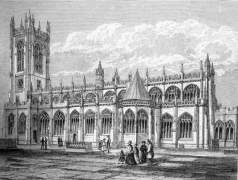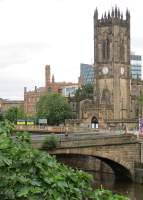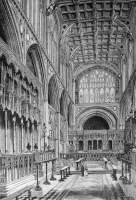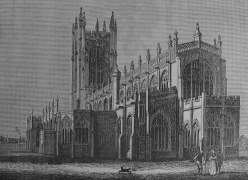Manchester Cathedral monuments
 Manchester Cathedral.
Manchester Cathedral.
Manchester Cathedral is an unusual building, which has been described somewhat loftily as ‘a very fine parish church’.
It can lay claim to a little more than that implies, though it is of course a building which has been promoted rather
than a purpose-built Cathedral. There was indeed some existing Parish Church building on the site in 1422,
when Thomas De la Warre (or Thomas Lord de la Ware), later the Baron of Manchester (he has a fine statue on the Town Hall, shown
holding a model of the Cathedral),
persuaded King Henry V that his church should become Collegiate, dedicated to the Virgin,
later being dissolved and refounded on more than one occasion in the 16th and 17th Centuries.
The Collegiate Church became a Cathedral in 1848, at which point its oldest part, the tower, which dated from pre 1400,
was declared unsafe and pulled down and replaced, despite George Gilbert Scott’s view that it might have been preserved.
The new, larger tower, thought more befitting for the new status of the edifice, was the work of the Chapter architect,
James P. Holden – a fine thing, particularly when viewed from across the bridge to Quay Street, but given what was lost,
a creation of the combined forces of Ecclesiastical and Architectural barbarism.
 Manchester Cathedral from beyond the bridge.
Manchester Cathedral from beyond the bridge.
What, then, do we see today? From the outside, it is the 19th Century work which we notice, but inside,
the immediate impact is of the extremely wide space, which consists of the nave, which is preserved from the early 15th
Century, along with some other work, aisles, and an outer set of chapels, making effectively a double set of aisles,
which date from a bit later, with a slightly different style. The central nave, with ornate ceiling, is high enough,
but still the overall feel is of remarkable breadth rather than height. Bombing in WW2 has taken its toll, and much has
been lost from what survived into the 20th Century. Among the losses was most of the Lady Chapel,
but the 15th Century wooden screen to this happily survives, with seven small carved standing figures and animals
higher up among the ornament. Lively medieval, well draped, and with grotesques under their feet.
Nearby we have a bit of sculpture far older, a late Saxon or early Norman relief of an angel, known as the Angel Stone,
discovered during the demolition of the mediaeval South Porch during the 19th Century.
19th Century figure sculpture on the Cathedral exterior. 

Of an apparently once-rich collection of monuments, there survive about eight significant works of sculpture,
and a number of panels. First the grander works:
- Thomas Ogden, and son Samuel Ogden, d.1766. Tablet with a central panel with Latin
inscription, on a grand monument with a backing of grey marble, forming receding pilasters, a tall obelisk above,
and blocky apron below, all decorated with white marble accoutrements. On the pilasters, hanging flowers and leaves.
On the obelisk, a cartouche with acanthus and scrolling, a wreath of oak leaves and acorns above, and attached,
draped classical pots to either side. And on the apron, a roundel enclosed by two fern fronds bearing the name
of the sculptor, Christopher Moon of Manchester, entirely obscure. Grandiose indeed.
- Charles Lawson, d.1807, with a Latin inscription, and above, a rather splendid group in high relief
showing the deceased seated in a a flowing robe, one arm raised dramatically, the other around the shoulder of a
small boy. A second boy, older, kneels in front of him, clasping his knee. The accoutrements are a bust of homer,
an owl for wisdom, and a beehive as symbol of Manchester. Under the inscription, a caduceus bearing an eagle,
in front of a crossed sword and shepherd’s crook, and a balance, thus getting in courage, justice, medicine and
religious piety all in one. A fine work by the sculptor John Bacon Jr.
- Elizabeth Trafford, d.1813, with lengthy inscription noting that she died with ‘the consoling hope,
that she has changed this scene of things for a better’, and Lieutenant Edmund Trafford, d.1813.
Above the panel, which rests on a dark backing, is an obelisk with a sculpture of a mourning girl against a pot,
with crucifix above her. Though a conventional enough subject, the girl has a particularly elegant half squatting,
half kneeling pose showing her figure to advantage. The sculptor was George Napper, who produced several works in the vicinity
of Manchester, and was an assistant of Bacon the Elder.
- Dauntesey Hulme, d.1828, with lengthy inscription, and below it, a panel depicting the Good Samaritan.
The composition is interesting, with the figure, kneeling, turbaned Samaritan, and donkey all of large size to fill
the space, with no particular frame, the edges being defined by the flat back and rear of the donkey,
a small tree to the right, and the ground. Attributed to Richard Westmacott, on what grounds is not clear.
- Thomas Fleming, d.1848. Marble standing statue, rather severe, with a well-modelled head.
The figure, slim and elegant in modern attire, stands touching a pedestal on which rests a scroll;
he carries a second scroll in his other hand. The pedestal is signed by E. H. Baily, London, 1851.
- Humphrey Chetham, d.1853, founder of the library and hospital in Manchester of that name,
shown as a larger than lifesize statue of an ascetic man, rather religious in manner, with short beard, moustaches,
long hair coming from under his tight-fitting skullcap, wearing ruff and cloak. He is seated, raised up on a square
pedestal, and in front of this is a schoolboy holding an open bible with a short quote from Psalms.
The work of William Theed Jr.
- Bishop Fraser, d.1885, the second Bishop of Manchester, whose statue by Woolner
stands in Albert Square. Here we have a recumbent figure, in a wall niche,
by the less well-known sculptor James Forsyth. He wears white robes, with carefully worked out drapery over
the visible arm, tied to make ruffs at the wrist, the further hand on a bible, his head supported on angled cushions,
with his crozier under him.
- Hugh Birley, d.1886, founder of various Manchester churches and schools, and Conservative MP,
a rather grand monument, being a heavy coffer tomb in stone and marble, with a recumbent effigy of the deceased on top.
Around the base are panels with quatrefoils etc, and square bosses of flowers and foliage, and just below the slab
on which the effigy lies, the memorial text in a rusticated font. Following a medieval convention, the drapery falls
is as if the figure was standing, thus horizontally towards the feet, rather than downwards to the base of the monument.
But who was the sculptor?
 Woodwork in the choir, 1506.
Woodwork in the choir, 1506.
The lesser monuments date from the mid-17th Century onwards:
- Robert Lever monument, a touching record of the death of six of his children at a young age through
to 1647.
- A fragment, Ranstorne? Lever, Gent, under a coat of arms in low relief with castles and a griffin.
- Another coat of arms on a small square backing, in marble, with a knight’s helm, a fragment from some
lost memorial.
- A worn stone panel, with a long Latin inscription, ill-lit so that I could not make out the name, dated 1663,
with a coat of arms.
- Jacob Chetham de Turton, d.1696?, a battered stone monument, with a border at the top with birds
and beasts among stylised foliage in low relief, and a large coat of arms at the base.
- Mrs Ann Hinde, d.1724, ‘who lived a Pattern of Exemplary Piety… and established the
Green-Gown School for the Cloathing and Educating 24 poor Children, which,
by good Management and a Concurrence of fortunate Circumstances, are in the Year 1788, increased to the Number of 50.’
A plain panel with nicely cut text.
- Richard Hartley, d.1739, with a short inscription, on a marble panel with receding pilasters
in darker marble, on the one side only bearing a hanging drape; there would have been one on the other side too.
Shelves above and below, and above, a Baroque little pediment with a top but no sides, enclosing a winged cherubic head.
On the apron are crossed palm fronds, and a little floral bracket, more like a corbel, at the base.
A well proportioned monument.
- Two plain panels commemorating various members of the Moss family, who died in the middle of the 18th
Century.
- William Clowes, d.1772, a plain panel with some curly typography, the remnant of a large mural monument.
- Plain panel to Henry Atherton, d.1816, of Lincoln’s Inn, a barrister, and wife Ann, d.1826,
co-heiress of Edward Byrom.
- Edward Greaves, d.1824, and wife Elizabeth Anne, d.1840.
He was High Sheriff of the County Palatine of Lancaster. Panel with shield above the inscription,
with a phoenix on top of it, and enough of a border at the top that we may suppose there was once a frame.
- Eleanora Byrom, d.1838, daughter and co-heiress of Edward Byrom, as the top half of a Gothic window,
with the side borders carved in two different leaf designs, and a small cross.
- Jonathan Dawson, d.1840, actively engaged in the repair and enlargement of the church in 1815.
Plain panel with curved top.
- Samuel Taylor, Justice of the Peace and Lieut Colonel of the Manchester and Salford Rifle Regiment
of Volunteers, tablet styled as a casket-end, with pediment bearing the coat of arms, and eared with two acroteria.
The date hidden behind a panel resting against the monument.
- A dark stone plaque to the City Battalions of the Manchester Regiment who served throughout WW1, with a small coat of arms.
- Sir Hubert Worthington RA, d.1963, a plain stone plaque in remembrance of the architect to
Manchester Cathedral after WW2, who restored the building after damage in 1940.
Aside from the monuments, we may note a modern group of the nativity, with the composition arranged as a triangle,
Joseph’s head formng the apex, the reclining Mary as the base, and the infant Christ held in the centre.
Not overly detailed, but Mary’s face has some feeling, and there is a well-captured pose of a lamb at her feet.
It is entitled the Holy Night Statue, and was sculpted by Josephina de Vasconcelios in 1992.
We may mention that a few bits of architectural stonework of late medieval times, decorated with figural scenes,
survive; for example some martyrdom scene with two winged demons holding a saint, a hunter and dog after some ruminant
on a hill, a brewer with two barrels, and bosses to the arches in the shape of kingly heads.
Added to these are 19th Century adornments in the shape of grotesque lions, and some work which looks of modern times.
There is a marble font of 1787, made by David Broad.
Also to be noted are a few brasses, not covered here, and the fine woodwork, particularly in the choir
of 16th Century and later, looking to have gone a makeover in the 19th Century, but this is not my area of expertise.
The choir woodwork is due to the munificence of James Stanley, warden until 1506, later Bishop of Ely.

Top of page
Manchester Albert Square
Sculpture in some towns in England // Sculptors // Introduction to church monuments
Home
Visits to this page from 17 Feb 2013: 8,751
 Manchester Cathedral.
Manchester Cathedral.
 Manchester Cathedral from beyond the bridge.
Manchester Cathedral from beyond the bridge.

